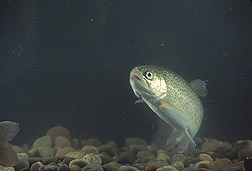This page has been archived and is being provided for reference purposes only. The page is no longer being updated, and therefore, links on the page may be invalid.
|
Read the magazine story to find out more. |
Trout Studies Seek Superior StrainsBy Marcia WoodDecember 26, 2001 Rainbow trout that flourish on grain-rich feed could be a plus for the environment and fish farmers alike. Fish geneticist Kenneth E. Overturf has pinpointed families of captive rainbow trout that thrive on grain. Overturf is with the Agricultural Research Service’s Small Grains and Potato Germplasm Research Unit at Aberdeen, ID, but is based at the University of Idaho’s Hagerman Fish Culture Station in Hagerman. ARS is the chief scientific research agency of the U.S. Department of Agriculture. Today’s fish feeds, the fish farmer’s biggest expense, are made with fishmeal from saltwater species such as anchovy, menhaden, jack mackerel or herring. Using more grain in fish feed would help prevent overfishing of these saltwater species. Also, captive fish that gain weight when fed grain specially bred by ARS research geneticist Victor Raboy, based in Aberdeen, may help sidestep phosphorous pollution of ponds, lakes, streams and rivers. Phosphorous pollution has been blamed for algal blooms that steal the oxygen needed by fish, insects and other aquatic dwellers. Raboy has developed barley and other grains that contain less phytate, a form of phosphorous that is difficult for fish to digest. That means these fish excrete less phosphorous in their manure. Trout fed the special grains could also save fish farmers money, because grain is currently less expensive than fishmeal. In all, Overturf has monitored growth of about 14,000 trout in tanks at the Hagerman station. He found that a significant percentage prospered on the grain-enriched feed. Some grew to a hefty 250 grams in as little as five months, making them equal in size to the biggest of their fishmeal-fed counterparts. Overturf and ARS technician Dan Bullock are now looking at trout DNA for a reliable indicator of the ability to gain weight and stay healthy on grain-based feed. For more, see this month's issue of Agricultural Research magazine. |

